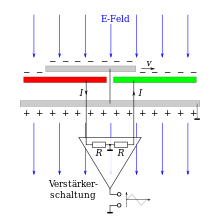
Back مقياس الحقل الكهربائي Arabic Elektrofeldmeter German Détecteur de foudre#Moulin à champ French Field mill IG




A field mill is a specialized instrument used for measuring the strength of electric fields in the atmosphere, one of the key parameters of atmospheric electricity. They are used in the launch criteria for rockets bound for orbit, as well as the now-retired Space Shuttle, to avoid lightning strikes. They are also used in outdoor laboratories for lightning protection equipment to determine favorable experiment conditions,[1] or simply to measure the atmospheric electric field away from thunderstorms.
The "mill" is a typical rotating shutter design in the instrument. It acts as a Chopper, converting the tiny DC signal of ambient static electricity into a tiny AC signal that is easier to detect without the amplifier's DC bias swamping it. It can be used on the ground, or deployed airborne and flown through anvil head clouds to make measurements.
- ^ KAPOW! Superhero Science (Television Documentary). Discovery Network; Actuality Productions. 2003.